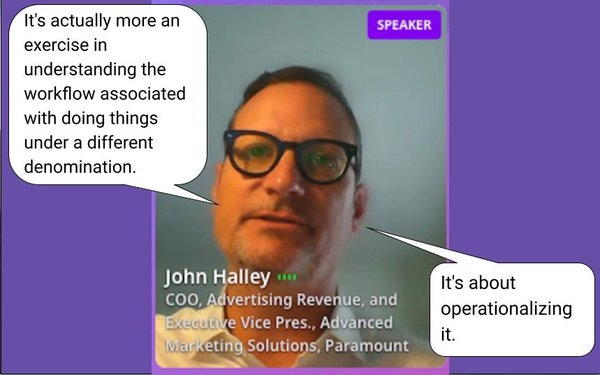Garbage In, Garbage Out

It’s one of the most fundamental principles of computer programming and data science, but based on some descriptions for the “test and learn” marketplace onboarding multiple, “alternative” currencies that advertising deals will be based on in the 2022-23 upfront marketplace, I think it is probably a good principle to keep in mind when it comes to media research — especially audience estimates.
But that’s not what I heard during the opening session on day two of the Advertising Research Foundation’s (ARF’s) Audiencexscience conference, which after listening to Paramount execs explaining it, maybe should be renamed Audiencexprocess.
“We’re at this phase right now where, you know, the methodologies, I think have been roughly understood and accepted, and now it’s a question of operationalization,” Paramount COO of Advertising Revenue John Halley explained during the day’s opening keynote, “Perspectives On Measurement And Why It Matters.”
Apparently, it doesn’t, because Halley and Paramount Chief Research Officer Colleen Fahey Rush did not actually discuss any measurement issues, but focused instead on “process” and “operationalization” during the keynote, which included no one from an advertiser, an agency or a neutral industry research authority, but was moderated by an Ad Age reporter.
“What we’re trying to do is make the point that alternative currency is not just a question of research and methodology,” Halley asserted, “It’s about operationalizing it.”
I’ve spent the much of the past couple of months focusing on another supplier’s similar claims — NBCUniversal’s — mainly because that company has been incredibly transparent about its process and ambitions in pushing through its alternative currency supply chain, “certifying” its preferred audience metrics suppliers, and lobbying against Nielsen’s long-standing role as the industry’s “currency.”
Personally, I’ve never understood the bum rush associated with the supply-side’s aggressiveness, and why after decades of covering a thoughtful, methodical industry-wide approach to currency change — you know, things like year-over-year comparative data before pushing the buttons or pulling the plugs — why there is such urgency.
And yes, I’ve heard from and even quoted some smart people from the demand-side — mainly agency execs who come largely from digital native backgrounds and say the reasons is that the industry’s culture has shifted, and that they no longer have time for the kind of methodological consideration they’ve used in the past before modifying the audience measurement estimates that are the basis for billions of dollars in their client’s ad spending.
I mean, I remember the conniptions the ad industry went through when Nielsen finally shifted to people meters from antiquated set meters and paper diaries for network TV ratings, and the Big 4 nets were estimated to lose $40 million in ratings shortfalls. And that was after years of methodological testing, and oodles of comparative data testing before that change was even implemented.
I also find it remarkable, that not one of the alternative currency suppliers — neither NBCU’s certified supplier, iSpot, nor Paramount’s VideoAmp — are currently accredited by the Media Rating Council, though at least iSpot is currently undergoing an audit.
I’ve never understood why the U.S. advertising industry doesn’t operate under the same kind of joint industry committee (JIC) protocols used by their counterparts in other countries to ensure fair and equitable research inputs and outputs — or why the demand-side in the U.S. always ends up capitulating to its suppliers on what their advertising buys are measured and accounted on. But hey, I’ve only covered this marketplace for 40 years, so what do I know?
I also don’t understand why people representing billions of dollars in advertising spending just roll over when one of their sellers flippantly says the methodologies of the data they will input have been “roughly understood and accepted” and are actually ready for prime-time operationalization.
Whatever happened to garbage in, garbage out?
Lastly, there’s another subplot in the 2022-23 alternative currency bum’s rush I’ve never quite understood, but it was touched on by Paramount’s Rush, which is why a marketplace comprised of multiple alternative currencies is actually a good thing for advertisers paying billions of dollars based on them?
“Every marketer has different needs, which is why I think it’s so necessary for us to be forging this much more innovative present in the future, where there is this array of choices of different data sets that can be harnessed to meet the advertisers’ needs,” she asserted, adding, ironically, “That is sort of our North Star right now.”
I say ironically, because having multiple, alternative metrics competing as an industry currency literally is the opposite meaning of a North Star, which is a universal point of reference.
I do understand the perfect storm of events that got us to this point, especially that Nielsen was its own worst enemy by dragging its feet and not moving faster to reboot its own antiquated measurement methodology and why other challengers hadn’t accelerated their own vetting process to at least become MRC certified — er, I mean accredited — instead of by media suppliers.
But this is where we are. Those are the inputs. And it will certainly be interesting to cover their outputs.
But I do find the argument that having multiple potential currencies competing for dominance — if not actual meaning — side-by-side is a good thing to be incredibly stupid.
I mean, does anyone remember the days when buyers and sellers would haggle over not just the price of their advertising deals, but the currency values of side-by-side TV ratings from Arbitron and Nielsen, or print audience estimates from MRI and Simmons?
It seemed pretty inefficient back then, and I’m going to go out on a ledge and say it’s not going to provide any more transparency today.
But maybe that’s the real reason why the demand-side has been so complacent? Could it be that it doesn’t actually like being held accountable to industry-standard metrics that everyone can see and agree on?
Whatever the reasons, it’s about to be operationalized by the biggest media suppliers in the world.
“As much as it is a question of research methodology, it’s actually more an exercise in understanding the workflow associated with doing things under a different denomination,” Paramount’s Halley explained. “It’s about operationalizing it.”
“Alternative currency is not just a question of research and methodology. It’s about operationalizing it.” MediaPost.com: Search & Performance Marketing Daily
(13)






